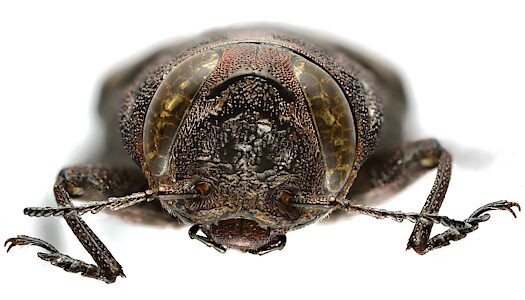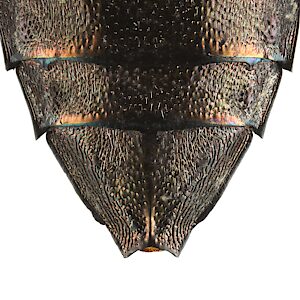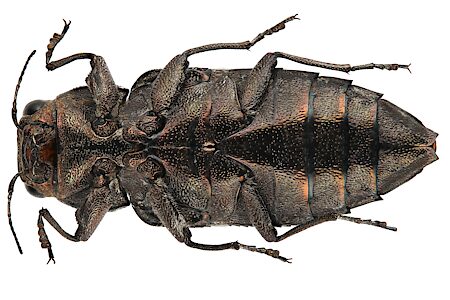Elytra with foveae relatively small, somewhat irregular in shape and well impressed, and with the costae conspicuous (but not as raised as in C. subsimilis), the two inner ones on each elytron largely complete, the outer one weaker and shorter. Pronotum largely punctate with limited development of transverse striae (cf. strong in C. subsimilis), somewhat flattened laterally, with relatively straight, gently curved to slightly angled sides, and two weak, obliquely elongate foveae along each side. Frons unevenly punctate, with areas of coalesced thickening and zones of differing relief; a gently arcuate/bow-shaped thickening on the brow adjoining vertex. Labrum coppery orange to red.
Apical abdominal ventrite with a strong median carina in female (but obscure or absent in male). Generally dark bronze below with some shiny copper colouration near posterior margins of abdominal ventrites but lacking the more extensive shiny colouration of C. mastersii (including C. blackburni) and C. sp. Wide pronotum. Also differs from those species (and from C. perroni in its smaller, less circular foveae. Lacks the prominent dense patch of long pale hairs on the metepimeron which characterises C. perroni, and more elongate in shape than C. sp. Wide pronotum.
A widely distributed pan-Australian species. Known on northern Eyre Peninsula by dead salt lake specimens collected by P. Hudson, three from a lake in the western part and three from a lake on the eastern side.
Hawkeswood & Turner 1997b provide a comprehensive, illustrated review of this species.
| Legend | records | count of breeding adults, pupae and larvae |
| sites | count of major sites (unique 10 km grid cells +/- some distinct approximate localities) |
| adult | live = extracted alive; dead = extracted dead as intact or fragmentary remains; ex billet = reared and emerged from stored sections of host; ex pupa = reared from sampled pupa |
| pupa | extracted pupa; pupa ex larva = reared pupa from larva |
| larva | extracted larva (any stage including prepupa) |
| gall (only) | hatched or unhatched gall identified by form and position rather than contents |
| Plant names in green are hyperlinked to a matching host species page with plant photos. |
The first breeding record presented here is an adult that I reared from a pupa in a dead branch of Nealie Wattle Acacia rigens collected c. 40 km NNE Renmark in Chowilla Regional Reserve. The elytra were damaged during emergence and their foveae are obscure but still discernible. Apart from this, it is a good match to intact adult specimens, including features of the apical abdominal ventrite.
This larval host species record is supported by a Chrysobothris larva, again from a dead branch of A. rigens. The latter was found much further southeast in the Murray (mallee) Region (MU), in the Bakara area, where several adult C. saundersii were collected by M.A. Hura, including two observed on Acacia rigens stems.
Previously, Hawkeswood 1986a described a breeding record from Acacia leiocaylx in southern Queensland. Hawkeswood & Turner 1997b documened breeding specimens from a fallen trunk of Drooping Sheoak Allocasuarina verticillata in NSW. The use of this unrelated plant species (which also happens to be widespread in SA) raises the possibiity that C. saundsersii may utilize a broad range of larval host plants.
| ¹ Legend | regions | SA State Herbarium regions (map)
EA: Eastern, EP: Eyre Peninsula, FR: Flinders Ranges, GT: Gairdner-Torrens, KI: Kangaroo Island, LE: Lake Eyre, MU: Murray, NL: Northern Lofty, NU: Nullarbor, NW: North-Western, SE: South-Eastern, SL: Southern Lofty, YP: Yorke Peninsula |
| size | The ellipse is the correct size when printed, indicative on a desktop screen, and likely to be wrong on a mobile device. |
























 dead branch, MU, L1_x300.jpg)
 dead branch, dorsal & ventral view, MU, L2_x300.jpg)
 dead branch, dorsal, MU, L3_x300.jpg)
 dead branch, ventral, MU, L4_x300.jpg)
 dead branch, 20.5 mm long, MU, P1_x300.jpg)
 dead branch, 20.5 mm long, MU, P2_x300.jpg)
 dead branch, 20.5 mm long, MU, P3_x300.jpg)



